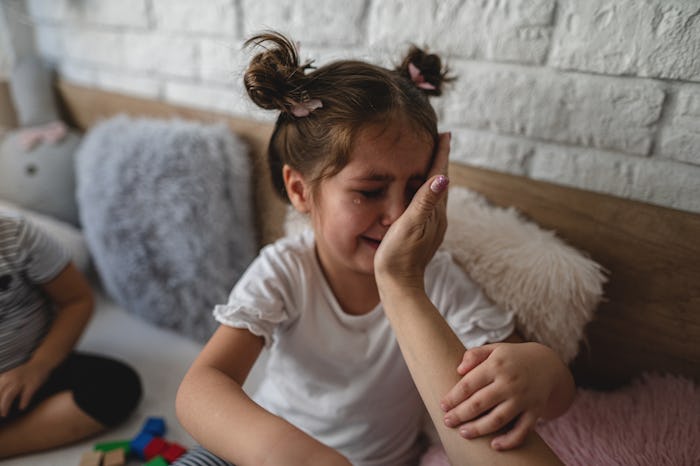It feels like babies and toddlers are constantly going through some sort of growth spurt, and honestly, it's because they are. These little ones have a lot of growing to do, and only a few short years to do it. But as your child grows into an older toddler, you might start to notice some discomfort in your child that you never noticed before. But to save yourself some anxiety, it helps to know the signs of growing pains so you can get your child (and yourself) some comfort.
"Growing pains are aches and pains in the legs that are not caused by any known injury or any other process," Dr. Jaime Friedman, M.D., pediatrician at Children’s Primary Care Medical Group 4S Ranch, explains to Romper. Although common, there's actually no science behind them. "While they are called growing pains, there isn’t evidence at this time that bone growth causes the pain," Friedman says.
Still, any parent can tell you that growing pains definitely seem like they happen. These aches and pains may be frustrating for a child, but they should never be serious. "When the child begins to show signs of swollen joints, redness, excessive pain, limping, weight loss, rashes, and any unusual behaviors, it may be something more serious than growing pains, and parents should consult a doctor," Dr. Rommel Morales, M.D., a pediatrician at Community Health of South Florida, Inc., tells Romper.
Your child will likely feel some, if not all, of the symptoms listed below, but it's pretty easy to relieve the pain. A gentle massage, a warm bath, or a heating pad on the area may be enough to make things better.
1They Experience Pain Between 3 To 5 Years Of Age
Physicians agree that growing pains typically occur around the same age for each child. "Growing pains tend to occur in preschool aged children, typically ages 3 to 5," says Friedman. But they're not over when kids are little. "They can return in school-age and young pre-teens as well." So if you notice your child complaining of aches around this age, there's a good chance it's just a growing pain.
2They're Experiencing Leg Pain
If your child is going through growing pains, the most common type of pain felt is leg pain, although not in the joints. "The child may experience deep aches, throbbing, and cramping in both legs, more specifically in the calves, shins, side of the legs, and behind the knees," explains Morales. "This type of pain is likely to occur in the muscles, tendons, and ligaments more so than in joints and ankles."
You might notice that the pain isn't that bad, or that it doesn't seem to hurt in one specific area — that's all normal. "Pains can be mild or severe enough to cause crying," Dr. Vanessa Slots, M.D., division chief of pediatrics at Renown Health, tells Romper. "They are generalized muscle pains not located to any one particular area."
3They Feel Pain Later In The Day
It's not uncommon for kids to go an entire day without feeling growing pains, only to feel them the moment they lay down for bed. Dr. Lora Tanis, pediatric chiropractor and ambassador from the Foundation for Chiropractic Progress, tells Romper that more often than not, these pains occur in the evening or during the night.
"It is also common that the pain occurs on nights of increased daily physical activity," Tanis adds. "The pain can range from nightly to sporadic." In other words, they may feel it some nights, and other nights, they might be totally fine.
4They Wake Up During The Night
It's not too surprising that nightly growing pains would cause a toddler to wake up throughout the night. Tanis says that "night waking with knee and leg pain is the most common symptom."
Since growing pains often happen after a particularly strenuous day, it may be possible to predict and prepare for night wakings. "My recommendation for parents is to keep records of their toddler’s daily activities to see when these growing pains occur more often," says Morales. "They can also do exercises with their toddler before bed — such as stretching — to help prevent growing pains."
5They May Feel Pain In Their Arms
"Legs are the most common area for growing pains to happen, but some children will experience them in the arms as well," says Slots. The pain would be similar to the legs: muscle aches rather than joint pain.
One important note is that growing pains will never be felt in a child's back. Friedman warns, "Back pain is not commonly associated with growing pains and should be assessed by a physician."
6Abdominal Pain
A less common sign of growing pains, although still a possible one, is abdominal pain. "Some children will report stomach aches as well, but that is rare," says Friedman. If you notice your toddler is experiencing abdominal pain as well as aches in their legs, it could be growing pains.
7Headaches
All of the experts agreed that headaches are another less common sign of growing pains. While they can happen because of growing pains, it's rare. So just be mindful of chalking up your child's recurring headache as a growing pain.
Experts:
Dr. Jaime Friedman, M.D., pediatrician at Children’s Primary Care Medical Group 4S Ranch and spokesperson for American Academy of Pediatrics, California Chapter 3
Dr. Rommel Morales, M.D., a pediatrician at Community Health of South Florida, Inc.
Dr. Vanessa Slots, M.D., division chief of pediatrics at Renown Health
Dr. Lora Tanis, pediatric chiropractor and ambassador from the Foundation for Chiropractic Progress
